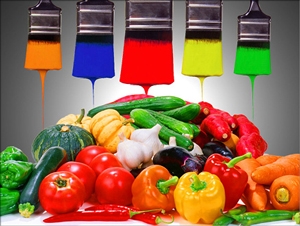Foods can be divided into categories based on their colours and each category has a collective set of health benefits. This not only makes foods interesting, but also helps remember which food is good for which health aspect.
Eating a variety of colourful food provides vitamins, minerals, and antioxidants to nourish your body that can’t be replicated in a supplement.
So what does colour have to do with diet anyway? One word: phytochemicals. These substances occur naturally only in plants and may provide health benefits beyond those that essential nutrients provide.
Colour, such as what makes a blueberry so blue, can indicate some of these substances, which are thought to work synergistically with vitamins, minerals, and fibre (all present in fruits and vegetables) in whole foods to promote good health and lower disease risk.
According to the Produce for Better Health Foundation (PBH), phytochemicals may act as antioxidants, protect and regenerate essential nutrients, and/or work to deactivate cancer-causing substances.
Benefits of Foods by Colours
Healthy eating advocates often tell people to “eat the rainbow”… You may have heard the phrase “eat the rainbow” before—and not just in Skittles commercials. Dietitians, doctors and other health and wellness advisors use the phrase to get people—especially children—to incorporate more fruits and veggies in their diets.
Foods are broadly divided into six categories based on their colours
White – Immune Support & Bone Health
 Just because a food is white, doesn’t mean that it isn’t nutritious. In fact, white foods such as low-fat (1%) or fat-free milk, yogurt, and some cheeses are packed with vitamin D, calcium, and phosphorus.
Just because a food is white, doesn’t mean that it isn’t nutritious. In fact, white foods such as low-fat (1%) or fat-free milk, yogurt, and some cheeses are packed with vitamin D, calcium, and phosphorus.
White fruit & veg are high in dietary fibre, helping to protect you from high cholesterol, and antioxidant-rich flavonoids, such as quercetin, which is abundant in apples and pears.
These vitamins and minerals aid in bone health and may help us maintain a healthy body weight. Yogurt also contains probiotics, which are bacteria that confer a health benefit, like promoting digestive health or supporting immune function.
While garlic & onions help reduce the risk of cancer in stomach, colon & rectum, white beans & potatoes help lower blood cholesterol levels. Mushrooms are known to provide the important nutrients and cauliflower contains antioxidants & is also beneficial for women who are pregnant.
They may also lower your risk of stroke, according to a group of Dutch researchers who published a study with the American Heart Association in 2011. After a 10-year diet study, they found that people with a high intake of white fruits and vegetables had a 52% lower risk of stroke.
Examples: Garlic, onions, white beans, potatoes, mushrooms and cauliflower, milk, cheese, yoghurt and cucumbers
Green – Detoxification & Cancer-Fighting
 The natural plant pigment chlorophyll colours green fruits and vegetables. In our system, the green foods represented those foods rich in isothiocyanates, which induce enzymes in the liver that assist the body in removing potentially carcinogenic compounds.
The natural plant pigment chlorophyll colours green fruits and vegetables. In our system, the green foods represented those foods rich in isothiocyanates, which induce enzymes in the liver that assist the body in removing potentially carcinogenic compounds.
Cruciferous veggies such as broccoli and cabbage contain the phytochemicals indoles and isothiocyanates, which may have anticancer properties.
Green vegetables are also excellent sources of vitamin K, folic acid, potassium, as well as carotenoids and omega-3 fatty acids. Their Vitamin K content helps your blood to clot properly.
Sulforaphane, a phytochemical present in cruciferous vegetables, was found to detoxify cancer-causing chemicals before they do damage to the body.
These foods’ antioxidant vitamins, particularly vitamins C and E, may lower your risk of chronic diseases. They provide the phytonutrients lutein and zeaxanthin, which may protect you from vision loss due to eye diseases such as macular degeneration
Examples: Broccoli, cabbage, bok choy, Brussels sprouts, Peas, spinach, green beans, capsicums, kiwi, and green tea.
Yellow – Beauty & Eye Health
 A variation of the green colour category, these foods exhibit a richness in lutein, which is particularly beneficial for eye health. They also contain a high amount of vitamin C.
A variation of the green colour category, these foods exhibit a richness in lutein, which is particularly beneficial for eye health. They also contain a high amount of vitamin C.
Yellow fruit & veg are full of carotenoids and bioflavonoids which represent a class of water soluble plant pigments that function as antioxidants.
Yellow food is extremely rich in retinol, a type of Vitamin A1 that acts upon acne and wrinkles in order to reverse the damage.
Studies suggest that these bountiful nutrients will help your heart, vision, digestion and immune system. Other benefits of naturally yellow foods include maintenance of healthy skin, wound healing, and stronger bones and teeth.
When you seek out and consume yellow-coloured foods, you nourish your body, mind and soul with many of Mother Nature’s health benefits.
Examples: Avocado, kiwifruit, spinach and other leafy greens, pistachios, Banana, yellow capsicum, squash and corn.
Orange – Cancer Prevention & Eye Health
 Orange foods are rich in beta-carotene, which are particularly good antioxidants. They are good for the heart, protect our eyes and also boost our immune system.
Orange foods are rich in beta-carotene, which are particularly good antioxidants. They are good for the heart, protect our eyes and also boost our immune system.
Beta-Carotene: The best-known nutrient in orange foods is beta carotene, a powerful antioxidant which gives sunny fruits and vegetables their brilliant colour. Beta carotene is not only good for eye health it can also delay cognitive aging and protect skin from sun damage.
Vitamin A: Beta carotene is a precursor for vitamin A, which is commonly referred to as retinal, retinol and retonoic acid. Vitamin A is important for night vision, as an antioxidant can neutralise the damaging free radicals in the body, and is crucial in the health of your immune system.
Vitamin C: Orange foods are chockfull of vitamin C, an antioxidant which boosts the immune system, protects against cardiovascular disease and helps rebuild collagen in the skin.
Examples: Carrots, mangos, cantaloupe, winter squash, sweet potatoes, pumpkins, apricots.
Red – Heart Health & Cancer-Fighting
 Lycopene is the predominant pigment in reddish fruits and veggies. A carotenoid, lycopene is a powerful antioxidant that has been associated with a reduced risk of some cancers, especially prostate cancer, and protection against heart attacks.
Lycopene is the predominant pigment in reddish fruits and veggies. A carotenoid, lycopene is a powerful antioxidant that has been associated with a reduced risk of some cancers, especially prostate cancer, and protection against heart attacks.
Look for tomato-based products for the most concentrated source of this phytochemical.
Although some nutrients, such as vitamin C, are diminished with the introduction of heat, the benefits of eating produce are not dependent on eating raw foods. In fact, cooking enhances the activity of some phytochemicals, such as lycopene. Obtaining optimal benefit from the nutrients in food, especially produce, depends on proper selection, storage, and cooking of the produce.
Cooked tomato sauces are associated with greater health benefits compared with the uncooked version because the heating process allows all carotenoids, including lycopene, to be more easily absorbed by the body.
In addition to vitamin C and folate, red fruits and vegetables are also sources of flavonoids, which reduce inflammation and have antioxidant properties. Cranberries, another red fruit [whose color is due to anthocyanins, not lycopene], are also a good source of tannins, which prevent bacteria from attaching to cells
Examples: Tomatoes and tomato products, watermelon, pink grapefruit, guava, cranberries, Red chillies, red cabbage, kidney beans, cherries, strawberries, beets, red capsicum, raspberries, cherries, tomatoes and apples.
Blue/Purple – Longevity & Antioxidant
 The blue/purple hues in foods are due primarily to their anthocyanin content; the darker the blue hue, the higher the phytochemical concentration. Blueberries are considered to have the highest antioxidant activity of all foods.
The blue/purple hues in foods are due primarily to their anthocyanin content; the darker the blue hue, the higher the phytochemical concentration. Blueberries are considered to have the highest antioxidant activity of all foods.
The anthocyanins that give these fruits their distinctive colours may help ward off heart disease by preventing clot formation.
Purple and blue foods also contain resveratrol which contributes greatly to your arterial walls (cleansing your blood circulation).
They also contain flavonoids and ellagic acid, compounds that may destroy cancer cells, according to the American Institute for Cancer Research.
Purple foods fight ulcers, help kill cancer, prevent urinary tract infection and are good for the heart & the liver.
Examples: Eggplant (especially the skin), blueberries, blackberries, prunes, plums, pomegranates
“Eating the Rainbow” is a good idea, but only as good as eating a balanced, healthful diet full of fresh foods.
Source: Benefits of Foods by Colours




Most Commented